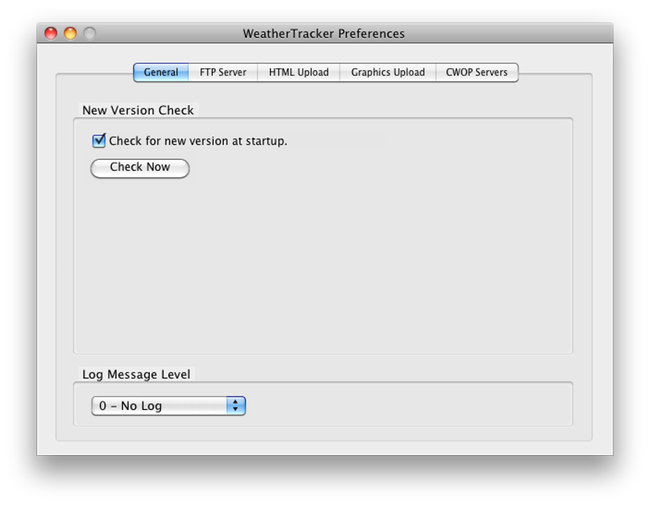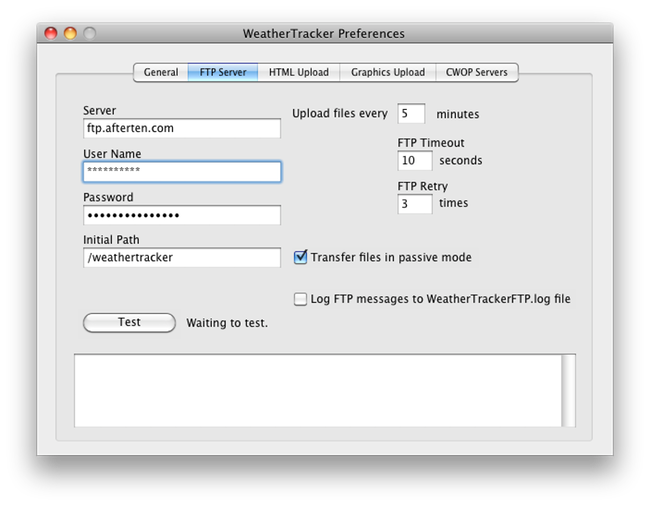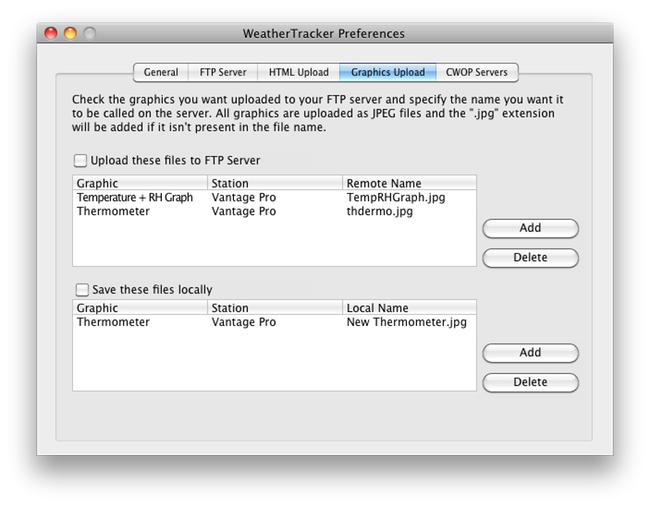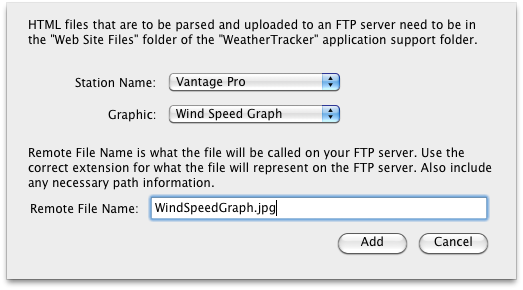You get to General Application Preferences by choosing "Preferences..." from the WeatherTracker menu. General application preferences are setting that effect the entire program and all the weather stations. The sections are...
1) General - Check for new version and set the detail level of the log message file
2) FTP server - If you are going to upload files with real-time weather data imbedded within the file then this is where you set up the FTP server parameters for logging into an FTP server.
3) HTML Upload - Here you will specify what text files will be parsed for weather tags. Weathertracker will replace the tags with weather data and then save the file using a new name and either save the new file to disk or upload a copy to the defined FTP server.
4) Graphics Upload - WeatherTracker has a list of pre-defined graphics that can be saved to a JPEG file on disk or uploaded to the defined FTP server.
5) CWOP Servers - If using the CWOP upload feature this section allows you to set the priority of CWOP servers to upload to. You generally never have to modify these fields since WeatherTracker can maintain them for you but they are here just in case of emergency.

If you want WeatherTracker to check for a newer released version at start up then check this box. Otherwise you can always do a manual check by clicking the "Check Now" button
WeatherTracker generates a log file in you Home/Library/Logs folder called "WeatherTracker.log"
The log file is visible using the "Console" application.
You can set the amount of detail that shows in the log using the "Log Message Level" menu. Typically you wouldn't touch this menu unless directed to by support.

WeatherTracker has the to read a text file from disk, look inside of it for specially formatted "weather tags" and replace the tags with actual weather data. It can then save this new file either back to the disk or to and FTP server. If you need to use this function then the "FTP Server" tab is where you set up the information WeatherTracker needs to log into your FTP server.
Server, User Name, Password - The typical information needed to log into an FTP server. If you FTP server runs on an unusual port then just append it to the Server like "afterten.com:145".
After filling in the Server, User Name and password fields you can click the "Test" button to do a simple test logon to the server to make sure everything is set up correctly.
Initial Path - If you know the folder on your FTP server where your uploaded fill will all go you can type in a path to that folder here. If you do not, not to worry as you can specify the full path when setting up individual graphics file to upload.
Upload files every X minutes - This controls the interval when WeatherTracker will parse the files and upload or save them to disk.
Transfer file in passive mode - Tells the FTP client if it should connect to the server in "passive mode". This is usually the most reliable mode.
Log FTP messages to WeatherTracker.log
Check this box if you want WeatherTracker to produce a log file showing all the details of an FTP transaction. The log file will be in Home/Library/Logs Again, this is typically not touched unless directed to by support.

Here is where you tell WeatherTracker what template files need to be parsed for weather tags and what the remote file name will be. Template files are simply text files that are on your hard drive that contain special tags that WeatherTracker will look for and replace with weather information.
For example your template file may contain this text...
The current weather in Muskegon, MI
Outside Temperature: <!-- wxdata type=otemp unit=f --> F
Wind Chill: <!-- wxdata type=wchi unit=f --> F
WeatherTracker, on a regular schedule (for example every five minutes), will read the file looking for the "<!-- wxdata ... -->" tags and replace those tags with real weather data. It will then write a new file to disk with a different name or FTP upload the file to your web server.
The output file would look like this...
The current weather in Muskegon, MI
Outside Temperature: 45 F
Wind Chill: 40 F
To add a file to be uploaded to your FTP server click the "Add" button in the upper section. You'll get the add file dialog.

The drop down menu lists all the file in a special "Web Site Templates" folder. You can go to this folder by clicking the "Go to HTML folder" button. Choose the source/template file from the drop downlist. In the remote file name section type what the name the file should be on the FTP server. If you want the file in a specific folder path on the server you can include it here. i.e. /MyWeather/WebSite/AllTags.txt
Click the "Add" button to confirm your settings.
To save a template file to the hard drive rather then FTPing them to a web server just click the "Add" button in the lower section. You'll get a similar add file dialog except you use a standard "Save File" dialog to choose where to save the folder and name the file.

WeatherTracker has several built in graphic files that you can upload to an FTP server for display on a web page or you can save the graphics to your hard drive.
To add a graphic to upload to the FTP server choose the "Add" button in the upper section. You'll get the add graphic upload dialog...

If you have multiple stations then choose the station for the graphic in the first drop down menu.
In the second drop down menu choose the graphic file to upload. The choices are...
- Thermometer
- Wind Direction Gauge
- Temperature Graph
- Temperature + RH graph
- Wind Speed Graph
- Wind Direction Graph
- Pressure Graph
- Solar Graph
- ETo Graph
- Screen Shot (A screen shot of the full station window)
- Screen Shot Short (screen shot of the full station window without the graph at the bottom)
Note that while every choice is always available not all graphs will produce interesting graphs for all stations. i.e If you choose ETo graph for a WMR968 weather station the graph will upload but will never contain any data.
In the remote file name section type what the name the graphic file should be on the FTP server. If you want the file in a specific folder path on the server you can include it here. i.e. /MyWeather/WebSite/WindSpeedGraph.jpg
To save a graphic file to the hard drive rather then FTPing it to a web server just click the "Add" button in the lower section. You'll get a similar add file dialog except you use a standard "Save File" dialog to choose where to save the folder and name the file.

This screen is for maintenance of the server used to upload weather data to the CWOP program. There is no need to change these servers unless directed to by AfterTen support.
The "Save CWOP data in WXNOW.txt file for external use" is for APRS users of CWOP. Again no need to check this unless you already have a need for a WXNOW.txt file for CWOP.